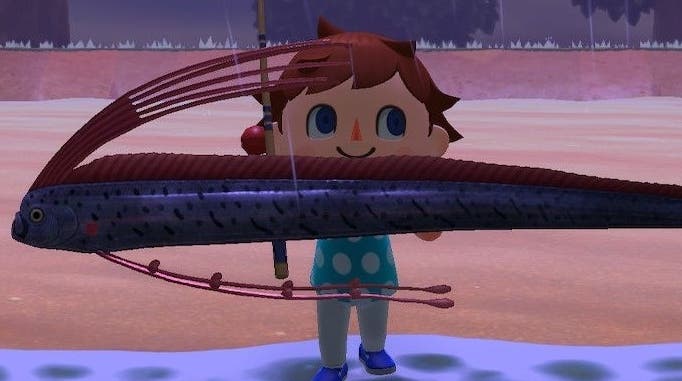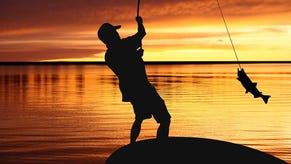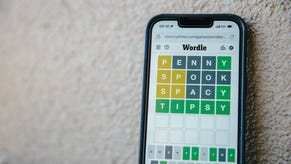Animal Crossing Fish list: All fish prices, locations, and how to catch rare fish with or without fish bait
All fish you can catch in Animal Crossing - and where to find them.
Fishing in Animal Crossing has proven to be one of the most popular activities throughout the series.
Catching fish several purposes - as something to collect and donate to the Museum, to make money with rare fish going for a high price.
Additionally, if you're not fussed about fleshing out the museum, you can also unlock an exclusive Golden Tool if you find every one.
As with bugs and many other aspects of the game, fish appear seasonally and changes each month, so you'll want to check in regularly.
This Animal Crossing fish list focuses on the Northern Hemisphere to show all fish as they come and go, but if you want a condensed look at the weeks ahead, we have a dedicated new fish and insects arriving and leaving this month page.
On this page:
How to increase your chances of catching fish in Animal Crossing: New Horizons
The basics of catching a fish are pretty simple. Once you have crafted a fishing rod, equip it at the edge of a body of water and cast it out near the outline of a fish. Wait until it starts nibbling, and once it goes under, press the A button to lure it in.

Of course, there are plenty of other things you should be aware of when it comes to fishing:
- All parts of the island - from the ocean shore to rivers, ponds, waterfalls, the mouths of rivers and even higher elevations - will see different fish appear.
- Though you cannot see what fish you are catching before you land it, both the location and the size can help narrow down any you might be looking for.
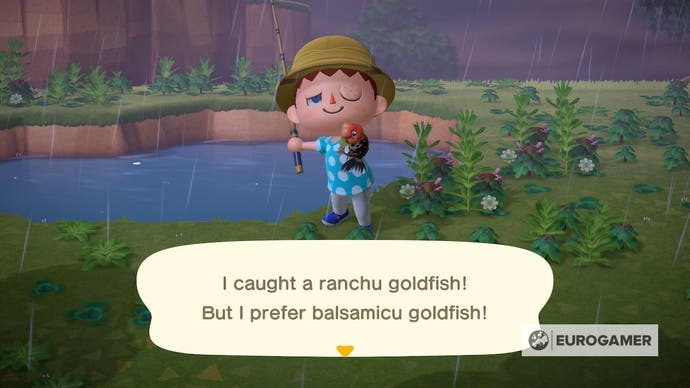
- When casting, aim for just in front of the fish. If it doesn't take notice straight away, pull the line up. Fish have different visibilities, try casting it closer next time.
- Make sure it has definitely ignored your line however, as if you cast too early, it'll swim away. If you're struggling to reach it, then reposition yourself and try again.
- If you're struggling to time pulling the lure - say if you're pulling the lure too early - it might be worth concentrating more on the sound and vibration over the sight of the fish going in for a bite. An extra tip by commenter TotesBreakfast says try closing your eyes to help you focus better (which is now our favourite fish catching method!)
- Either way, the fish will only nibble a total of five times before it goes under and you have to reel it in.
- Not only does location and weather impact fish spawns, but so does the time of day and the time of year. Our fish list at the end of this article can show you where and when you should be timing things.
- Fishing is one of the few interactions you can make when playing with friends in multiplayer without being a Best Friend - and makes for a relaxing social activity even if you are!
- If you're looking for a specific fish in a small area - say a river cliff top, or river mouth - try scaring other nearby fish away, either by pulling and withdrawing your lure, or running along the water's edge. The game will only spawn a certain number of fish within a radius, so if you run along the coast, scaring everything away, then come back, you can force a fish to spawn where you first started.
- Once you have unlocked terraforming, you can create your own ponds and greater expanses of river clifftops to increase your chances of those fish spawning there. You cannot edit or add to the pier or river mouth areas however.
Perhaps one of the best pieces of advice for finding rare fish, however, is to use lure...
How to catch fish using fish bait with a Manila Clam explained
As you've been exploring the shores of your island, you might have seen little holes appear with spirts of water.
Digging at these locations can result in items being found, but one of the most common is the Manila Clam.

When you find one of these for the first time, you'll learn a DIY recipe for Fish Bait. Head to a DIY workshop to craft this whenever you're ready.

To use Fish Bait in Animal Crossing, stand at water and select the item from your inventory, where you'll be given the option to 'Scatter Food'. Doing so will cause a fish to instantly appear, allowing you to fish there.
This fish won't be any rarer than any you might find ordinarily, but the benefit of using Fish Bait is you can control where they appear. This means if you're looking for a fish in an awkward location - such as on a pier, or in the mouth of a river - it will force one to spawn there.
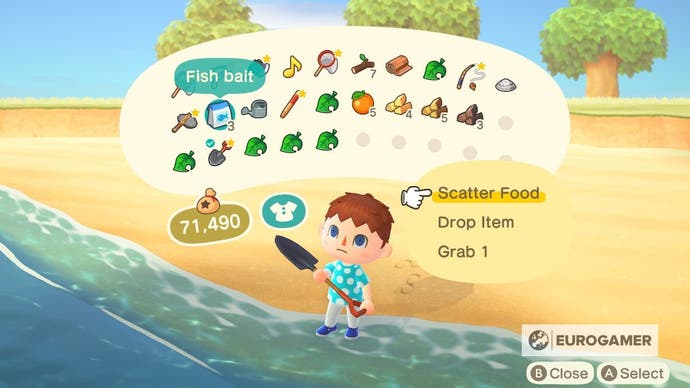
Note according to Mecal00 on reddit, it has been known that fish bait can make rare fish appear outside of their required circumstances - such as a Coelacanth when it isn't raining. This could be a bug, and either way, the chances of this spawning are still very small - but useful to know regardless!
Ultimately, Fish Bait isn't an essential item when it comes to fishing - but saves having to run back and forth until one appears where you need it to.
How to catch rare fish and the highest fish prices in Animal Crossing: New Horizons explained
As you might expect, the rarer the fish, the higher the price it will sell for in the shop - making for a welcome money making opportunity.
But as implied, even if you know the correct time and place of where they will appear, finding these fish are difficult - requiring a dose of luck to appear, then some skill in catching them, especially as rarer fish tend to be more skittish when biting the lure.
If you're after rarer fish, especially to sell, there are some rules to follow:
- If you're planning to make money, keep scanning the sea as it's where most expensive larger fish can appear, so stick to the coast (and when you can, also check in the pier area).
- If a fish has a fin, it's likely to be a shark - and is one of the few fish types you can spot ahead of catching.
- Though lures don't increase your chances, they will force a fish to appear in unusual locations, such as the pier - saving you some effort in waiting.
- Though rain is unconfirmed to increase numbers or chances of certain types of fish, the infamous Coelacanth will only appear when it rains - which can give you an extra incentive to get out to the coast when it does.
- Mystery Islands have higher fish spawns than your island. Though the layout is random - some could have a river cliff, while others will only spawn trash for you to catch - it can help you better catch fish in certain locations, especially if you use the 'scaring' tactic mentioned earlier.
- Ultimately - aside from known factors such as time of day, year and island location, rare fish appear by luck, so it's a case of fishing again, and again, and again...
It's worth adding though some fish can sell for up to 15,000 Bells each, the chances of catching enough to make it worth prioritising over other make money opportunities - such as finding Tarantulas and Butterflies - is unlikely. As a result, see fishing as more of a completionist exercise than a lucrative one!
Though not an exhaustive list of rare fish or fish prices, here are our recommendations on how to catch rare fish in Animal Crossing: New Horizons. Note - all months mentioned are for the Northern Hemisphere:
Football Fish (fish price - 5,000 Bells) - If you want a balance of finding a fish which is uncommon but fetches a good price, we'd recommend looking for Football Fish. These appear in the sea, between November and March, and 4pm to 9am.
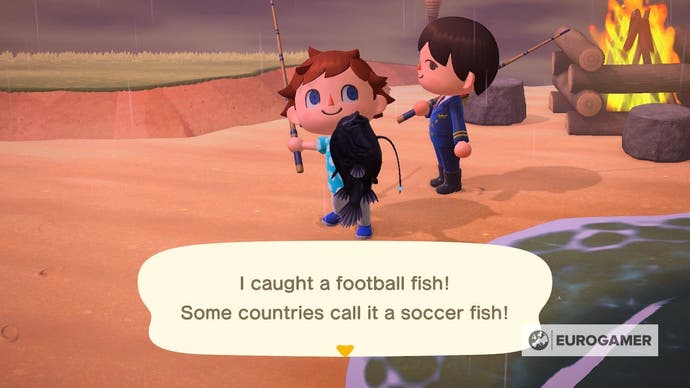
Oarfish (fish price - 9,000 Bells) - The Oarfish is perhaps one of the more 'surprising' rare fish which, despite its huge size when caught, looks like a regular 'large' fish in the water, meaning you're likely to stumbling upon it by accident. You'll find this in the sea at any time of day between December and May.
Golden Trout (fish price 15,000 Bells) - Found between March to May and September to November between 4pm and 9am, you'll find the Golden Trout in the hardest place to reach on the island - the source of the river at the highest elevation. Bring a ladder and a few fish baits with you - that way you can keep spawning them without having to travel back and forth. It's very, very rare - but keep trying!
Blue Marlin (fish price 10,000 Bells) - You can find this all day between November to April and July to September. It's one of the few fish which appears at the pier - so have a quick glance when you pass by it, or use some fish bait to encourage it out.
Sharks (fish prices - between 8,000 Bells and 15,000 Bells) - There are many different varieties throughout the year, but as long as you fish out at sea, and fish in the evening hours (between 4pm and 9am) there's a (rare) chance you can find one. If you see a fin on the fish silhouette before you catch it, then you're in luck. Just hope you catch it!
Coelacanth (fish price - 15,000 Bells) - Infamous for being one of the rarest fish in the Animal Crossing series, Coelacanth is back in New Horizons. The rules for this one are pretty simple - it needs to rain, but otherwise it's available all year round, at all times of day, and from the ocean. Fingers crossed it makes an appearance.
The Animal Crossing 2.0 update and Happy Home Paradise is here! We can help you with the new additions - including where to find Brewster, Gyroids, new villagers, ordinances, new fences, storage shed, new hairstyles, Froggy Chair, group stretching and Kapp'n boat tours. Cooking is now unlockable, so you need to know how to make both flour and sugar, as well as how to grow carrots, potatoes and tomatoes. Meanwhile, if you're new to Animal Crossing, our New Horizons tips can help with the basics. From the off, there's fish and bugs to catch, flowers and fruit to grow with. One long term goal is building your Happy Home Academy score. Finally, you need tools such as the new ladder and vaulting pole to fully explore.
Animal Crossing: New Horizons All Fish and their prices list
Here is a list of all fish in Animal Crossing: New Horizons, as well as their spawning conditions and other behaviours.
Remember, fish will come in and out of rotation throughout the year, so it's impossible to get everything at any given time. If you're hoping to get them all and want to see what's urgent - the things about to leave, and what's appearing - our dedicated new fish and insects arriving this month page can help you see these at a glance.
It should be noted the following are for the northern hemisphere. For the southern hemisphere, each set of dates will differ by six months.
Here are all fish in Animal Crossing: New Horizons, in the order they appear in the Critterpedia:
| Animal Crossing Fish | Months available | Times available | Location | Fish Price |
|---|---|---|---|---|
| Bitterling | November to March (Northern hemisphere) May to September (Southern hemisphere) | 24 hours | River | 900 |
| Pale chub | All year round | 9am to 4pm | River | 200 |
| Crucian Carp | All year round | 24 hours | River | 160 |
| Dace | All year round | 4pm to 9am | River | 240 |
| Carp | All year round | 24 hours | Pond | 300 |
| Koi | All year round | 4pm to 9am | Pond | 4000 |
| Goldfish | All year round | 24 hours | Pond | 1300 |
| Pop-eyed Goldfish | All year round | 9am to 4pm | Pond | 1300 |
| Ranchu Goldfish | All year round | 9am to 4pm | Pond | 4500 |
| Killifish | April to August (Northern hemisphere) October to February (Southern hemisphere) | 24 hours | Pond | 300 |
| Crawfish | April to September (Northern hemisphere) October to April (Southern hemisphere) | 24 hours | Pond | 200 |
| Soft-shelled Turtle | August to September (Northern hemisphere) February to March (Southern hemisphere) | 4pm to 9am | River | 3750 |
| Snapping Turtle | April to October (Northern hemisphere) October to April (Southern hemisphere) | 9pm to 4am | River | 5000 |
| Tadpole | March to July (Northern hemisphere) September to January (Southern hemisphere) | 24 hours | Pond | 100 |
| Frog | May to August (Northern hemisphere) November to February (Southern hemisphere) | 24 hours | Pond | 120 |
| Freshwater Goby | All year round | 4pm to 9am | River | 400 |
| Loach | March to May (Northern hemisphere) September to November (Southern hemisphere) | 24 hours | River | 400 |
| Catfish | May to October (Northern hemisphere) November to April (Southern hemisphere) | 4pm to 9am | Pond | 800 |
| Giant Snakehead | June to August (Northern hemisphere) December to February (Southern hemisphere) | 9am to 4pm | Pond | 5500 |
| Bluegill | All year round | 9am to 4pm | River | 180 |
| Yellow Perch | October to March (Northern hemisphere) April to October (Southern hemisphere) | 24 hours | River | 300 |
| Black Bass | All year round | 24 hours | River | 400 |
| Tilapia | June to October (Northern hemisphere) December to April (Southern hemisphere) | 24 hours | River | 800 |
| Pike | September to December (Northern hemisphere) March to June (Southern hemisphere) | 24 hours | River | 1800 |
| Pond Smelt | December to February (Northern hemisphere) June to August (Southern hemisphere) | 24 hours | River | 400 |
| Sweetfish | July to September(Northern hemisphere) January to March (Southern hemisphere) | 24 hours | River | 900 |
| Cherry Salmon | March to June / September to November (Northern hemisphere) March to May / September to December (Southern hemisphere) | 4pm to 9am | Clifftop river | 800 |
| Char | March to June / September to November (Northern hemisphere) March to May / September to December (Southern hemisphere) | 4pm to 9am | Clifftop river | 3800 |
| Golden Trout | March to May / September to November (Northern hemisphere) March to May / September to November (Southern hemisphere) | 4pm to 9am | Clifftop river | 15000 |
| Stringfish | December to March (Northern hemisphere) June to September (Southern hemisphere) | 4pm to 9am | Clifftop river | 15000 |
| Salmon | September (Northern hemisphere) March (Southern hemisphere) | 24 hours | Rivermouth | 700 |
| King Salmon | September (Northern hemisphere) March (Southern hemisphere) | 24 hours | Rivermouth | 1800 |
| Mitten Crab | September to November (Northern hemisphere) March to May (Southern hemisphere) | 4pm to 9am | River | 2000 |
| Guppy | April to November (Northern hemisphere) October to May (Southern hemisphere) | 9am to 4pm | River | 1300 |
| Nibble Fish | May to September (Northern hemisphere) November to March (Southern hemisphere) | 9am to 4pm | River | 1500 |
| Anglefish | May to October (Northern hemisphere) November to April (Southern hemisphere) | 4pm to 9am | River | 3000 |
| Betta | May to October (Northern hemisphere) November to April (Southern hemisphere) | 9am to 4pm | River | 2500 |
| Neon Tetra | April to November (Northern hemisphere) October to May (Southern hemisphere) | 9am to 4pm | River | 500 |
| Rainbowfish | May to October (Northern hemisphere) November to April (Southern hemisphere) | 9am to 4pm | River | 800 |
| Piranha | June to September (Northern hemisphere) December to March (Southern hemisphere) | 9am to 4pm 9pm to 4am | River | 2500 |
| Arowana | June to September (Northern hemisphere) December to March (Southern hemisphere) | 4pm to 9am | River | 10000 |
| Dorado | June to September (Northern hemisphere) December to March (Southern hemisphere) | 4am to 9pm | River | 15000 |
| Gar | June to September (Northern hemisphere) December to March (Southern hemisphere) | 4pm to 9am | Pond | 6000 |
| Arapaima | June to September (Northern hemisphere) December to March (Southern hemisphere) | 4pm to 9am | River | 10000 |
| Saddled Bichir | June to September (Northern hemisphere) December to March (Southern hemisphere) | 9pm to 4am | River | 4000 |
| Sturgeon | September to March (Northern hemisphere) March to September (Southern hemisphere) | 24 hours | River (Mouth) | 10000 |
| Sea Butterfly | December to March (Northern hemisphere) June to September (Southern hemisphere) | 24 hours | Sea | 1000 |
| Seahorse | April to November (Northern hemisphere) October to May (Southern hemisphere) | 24 hours | Sea | 1100 |
| Clownfish | April to September (Northern hemisphere) October to March (Southern hemisphere) | 24 hours | Sea | 650 |
| Surgeonfish | April to September (Northern hemisphere) October to March (Southern hemisphere) | 24 hours | Sea | 1000 |
| Butterfly Fish | April to September (Northern hemisphere) October to March (Southern hemisphere) | 24 hours | Sea | 1000 |
| Napoelonfish | July to August (Northern hemisphere) January to February (Southern hemisphere) | 4am to 9pm | Sea | 10000 |
| Zebra Turkeyfish | April to November (Northern hemisphere) October to May (Southern hemisphere) | 24 hours | Sea | 500 |
| Blowfish | November to February (Northern hemisphere) May to August (Southern hemisphere) | 9pm to 4am | Sea | 5000 |
| Puffer Fish | July to September (Northern hemisphere) January to March (Southern hemisphere) | 24 hours | Sea | 250 |
| Anchovy | All year round | 4am to 9pm | Sea | 200 |
| Horse Mackerel | All year round | 24 hours | Sea | 150 |
| Barred Knifejaw | March to November (Northern hemisphere) September to March (Southern hemisphere) | 24 hours | Sea | 5000 |
| Sea Bass | All year round | 24 hours | Sea | 400 |
| Red Snapper | All year round | 24 hours | Sea | 3000 |
| Dab | October to April (Northern hemisphere) April to October (Southern hemisphere) | 24 hours | Sea | 300 |
| Olive Flounder | All year round | 24 hours | Sea | 800 |
| Squid | December to August (Northern hemisphere) June to February (Southern hemisphere) | 24 hours | Sea | 500 |
| Moray Eel | August to October (Northern hemisphere) February to April (Southern hemisphere) | 24 hours | Sea | 2000 |
| Ribbon Eel | June to October (Northern hemisphere) December to April (Southern hemisphere) | 24 hours | Sea | 600 |
| Tuna | November to April (Northern hemisphere) May to September (Southern hemisphere) | 24 hours | Pier | 7000 |
| Blue Marlin | November to April / July to September (Northern hemisphere) January to March / May to November (Southern hemisphere) | 24 hours | Pier | 10000 |
| Giant Trevally | May to October (Northern hemisphere) November to April (Southern hemisphere) | 24 hours | Pier | 4500 |
| Mahi-Mahi | May to October (Northern hemisphere) November to April (Southern hemisphere) | 24 hours | Pier | 6000 |
| Ocean Sunfish | July to September (Northern hemisphere) January to March (Southern hemisphere) | 4am to 9pm | Sea | 4000 |
| Ray | August to November (Northern hemisphere) February to March (Southern hemisphere) | 4am to 9pm | Sea | 3000 |
| Saw Shark | June to September (Northern hemisphere) December to March (Southern hemisphere) | 4pm to 9am | Sea | 12000 |
| Hammerhead Shark | June to September (Northern hemisphere) December to March (Southern hemisphere) | 4pm to 9am | Sea | 8000 |
| Great White Shark | June to September (Northern hemisphere) December to March (Southern hemisphere) | 4pm to 9am | Sea | 15000 |
| Whale Shark | June to September (Northern hemisphere) December to March (Southern hemisphere) | 24 hours | Sea | 13000 |
| Suckerfish | June to September (Northern hemisphere) December to March (Southern hemisphere) | 24 hours | Sea | 1500 |
| Football Fish | November to March (Northern hemisphere) May to September (Southern hemisphere) | 4pm to 9am | Sea | 2500 |
| Oarfish | December to May (Northern hemisphere) June to November (Southern hemisphere) | 24 hours | Sea | 9000 |
| Barreleye | All year round | 9pm to 4am | Sea | 15000 |
| Coelacanth | All year round (must be raining) | 24 hours | Sea | 15000 |
Best of luck finding those fish!
